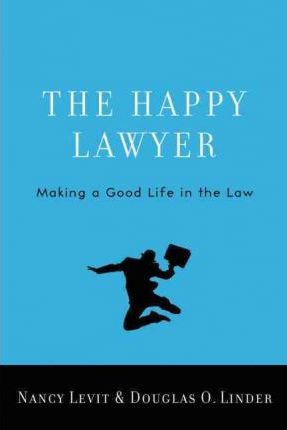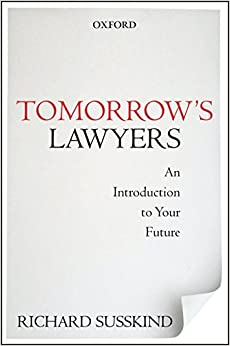Part IIIB
Second Preface
This subsection will follow the general format of Part IIIA. It might be valuable to read the Preface to that section. (Of course, it would almost certainly be beneficial to you to read Parts I & II.) It is also important to know that these blogs are critiques of the philosophy-psychology-&-sociology underlying an excellent book entitled THE HAPPY LAWYER. The foci of my doubts are the work of others. This is not intended to be lengthy book reviews. However, see Richard Delgado, Recent Writings on Law and Happiness, 97 SEATTLE UNIVERSITY SCHOOL OF LAW 913, 915-26 (2012).
In general, the book explores a lot of different approaches for lawyers to try and make themselves happier or to keep themselves happy, or at least at an increased level of happiness, once they have succeeded at achieving some higher level of happiness than they started with. Our Authors do this by focusing on what they take to be empirically established relevant general propositions, and then explicitly or implicitly suggest that these general propositions can be translated into normative principles (or maybe followable norms) designed for enabling reaching out for a happier life. (They specifically refuse to call them “recipes,” the assertion being equivalent to the idea that the principles they recommend will, if followed, always produce what was wanted.) Whatever they are called, somewhere around here, their recommendations and advice come inbuilt upon what is generally understood “around and about” as objectively factual ideas.
Alas, some of these foundational propositions are not at all empirically established–in fact, this is true of most of them, but are based on common sense, or so our authors say. I am skeptical about this approach, even though it is the prevailing approach in contemporary relevant departments of contemporary universities In a way, one of the approaches I am denying, to a considerable extent, and then also exploring briefly a very old yet also contemporary approach to dealing with happiness acquisition, and, if successful, probably also the achievement of overall satisfaction in life. The approach of this book is to apply what might be called the “Modern Methodology for Happiness Improvement.”
There is no intention on the part of Our Authors to suggest that there is a magic formula for lawyers, or anyone else, to find happiness. Our Authors have this right. (I remind the reader that I am not criticizing the job our authors have done. Their work was done well. My complaint is about an approach that regards itself and is regarded as the approach. If I believe anything in this context, it is that the “Modern Method” for happiness is dead wrong from beginning to end.
_________________________________________________________________________________
An Additional General Approach to Happiness Acquisition
According to Our Authors, the following ideas portray internal states of people such that the achievement (or the having) of which–or at least some of which–is crucial to human flourishing and hence happiness. Some of these are social or societal states of affairs—or, virtues—the way a person participates in at least some of them, and the extent to which s/he does so is
crucial for happiness:
1. Courage
2. Humanity
3. Justice
4. Temperance
5. Transcendence
6. Wisdom
To build a satisfying, thriving, flourishing, and therefore happy life, say the sources of the authors and the authors, as well, one should focus on the characteristics they possess and build on them. The few characteristics one does possess, become that person’s “signature strengths.” Source: Christopher Peterson & Martin E.P. Seligman, Values in Action (VIA) Classification of Strengths, Jan. 4, 2003, http://www.ppc.sas.upenn.edu/viamanualintro.pdf, at 4.
Character Strengths and Virtues: A Handbook and Classification Christopher Peterson & Martin E.P. Seligman eds. 2004) (hereinafter, P-S). Text and Citation: Happy Lawyer, p. 146-7, n. 99, p. 267. (Hereafter, this group will be called “Seligman,” since he was the architect of the whole approach.)
Seligman “[‘posit’] that [all] people have at least [a handful] of these characteristics as their ‘signature strengths.’ Indications of signature strengths are that people feel that the strength is an authentic reflection of who they are, have a fast learning curve for activities tied to that strength, and are invigorated and excited when using that strength.”
In other words, says Seligman, people should build on the strength; it is pointless to try to proceed by correcting and then trying to build on traits that are absent, smaller than others, or substantial but not, what might be called, “signatorial.” [I confess, in passing, that I am sick to damn death of the cliche “signature” used in this kind of context, including conversations one hears in student-faculty taverns. Seligman and his band should denounce them publicly and in a place that will affect the world of American English. Try the New York Times and/or the New York Review of Books and/or the Wall Street Journal. Now that I’ve gotten that off my chest, back to work.]
The empirical claim is that the forgoing assertions and those to come in a moment–or “posit[s]”–are actually a description of the nature of persons in general. I begin by being skeptical of the Seligman theses. They do not actually explicitly assert, at least as reported by our authors, that their system of six (6) general virtues is descriptive of facts about the nature of man, but that is clearly simplified. Notice that there are five problems here.
(i) One of them is that their evidence, is weak. (ii) The second one is that there is no good reason to think their “Deep Six” are exhaustive. (iii) The third is whether their analysis, of their list, is coherent. (iv) The fourth pertains to if and how the virtues apply to lawyers in some special way.
(v) And, of course, the whole idea of a “posit” being the central building-block, undermines the idea that what Seligman concluded is empirically established. A “posit” of an idea is not a rational conclusion. It is not something established by any set of facts. It is not even a hypothesis. It is more like an assumption that is used as a starting point–the basis–for a theory (or something like it).
With regard to the first problem, I have looked at the major work of Seligman, and I do not think they establish their theses about “signatures.” Are they gold mines as to who people really are? Is that what a signature is supposed to do? I thought it was for making sure that I am writing the check and someone else? How does the idea of a “signature this,” or a “signature that” really work? What’s wrong with just saying “Quinn has this virtue but not that one.” He has this weakness, but not that one.” He has four strengths, one of which is evil, one of which is neutral, and two of which are morally upright.
In using the signature metaphor, we would have to leave open the state of affairs in which Quinn’s signatures as unreadable. What would this mean?
In any case, I will focus on the general matters presented to our authors and then relied upon them. Ultimately, I am only interested in relationships between the Seligman Theory and being a lawyer, the doing of lawyerly things, how and where
one is stuck in the profession, and what all this has to do with the happiness of lawyers.]
Here is the Seligman characterization of the elements of the six (6) just listed:
“Courage [C] encompasses bravery, industry (perseverance and diligence), honesty, (authenticity, sincerity, and integrity), and vitality.”
“Justice [J] includes citizenship and teamwork, fairness, and leadership.
“Temperance [Tp] consists of forgiveness and mercy, modesty and humility, prudence, and regulation of oneself.”
“Transcendence [Tr] is comprised of an appreciation of beauty and excellence (awe and wonder), gratitude, hope (optimism, future-mindedness, future orientation), playfulness and humor, and spirituality.”
“Wisdom [W] contains creativity (originality and ingenuity), curiosity, active open-mindedness, love of learning, and perspective” (p. 267 n. 99)
At this point, one must remember that each of these 6 is treated as a “signature.” Some people have 2 or 3 of this one, while another person has 3 or so of that one. The problem here is that the propositions are nothing like signatures, whether for strengths, virtues, weaknesses, or vices. None of them is a signature, and none of them is a unified whole.
A very quick and selective survey demonstrates this:
C: does not require industry, perseverance, diligence, honesty, or others, although it sometimes requires bravery.
J: Being just does not require having leadership, etc.
Tp: I am not clear what temperance might be but whatever it is, it is unlikely that being temperate requires being forgiving, although, under the usual understanding, it requires self-restraint. Fantasies of revenge are enjoyable, and under some circumstances, taking revenge or high-risk action is a good idea, as might taking a dangerous, high-risk action. Also, where is the idea of civility? Why has it been left off? Maybe Tp teaches that one should shrug in the fact of minor injuries, instead of building up a mountain of hate. Maybe Tp improvement is a sibling of anger management.
Tr: A strong sense of aesthetics and optimism has nothing to do with each other.
W: Oddly enough this complex concept is nearly correctly described. However, the idea of actually having knowledge is left out. As a result, so is self-knowledge, and it is an absolute precondition for having wisdom. It is possible that a wise person has no love of learning at all, so long as learning means that a person loves something academic, sort of, and respects those who write insightful histories or study received psychology. Tractor repairmen who drink beer every day with their feet up on a bar with their buddies can be very wise about all sorts of important things, although they are not likely to be fond of Dante or Milton if they have ever heard of them. Indeed, they may hold such interests in contempt.
There is another problem. Our Authors, no doubt following the ideas of Seligman suggest that the way to figure out which of these “signatures” is strength is for one to give him/her self tests. Our authors create a series of tables each containing lots and lots of questions. Since these “signatures” are actually incoherent, one would have to do each of the components by itself. The most striking example of this problem is Tp.
There is a third problem. This one would apply to all sorts of categories of people, but it applies to lawyers quite clearly. Courage differs depending on the situation. Consider the difference between Lawyer & Client and Lawyer & Firm. To be sure, courage always requires having guts. The use of guts can be to take action, in other contexts it can be to refrain from action. In some cases, it takes a voice (here loud and there soft); in some cases it takes silence.
(1-Clients) Courage in representing clients is easy enough to understand for usual situations. It is related to the concept of being vigorous for a client. Given social circumstances, sometimes that takes courage; consider representing a murderer who also shot a female of congress in her head and ruined her political career. I suspect that would take a more radical kind of courage. It may even exemplify a certain kind of nobility. What would not be part of courage is profound and/or continuous sincerity. In addition, perseverance and diligence do not imply courage. If there are two lawyers, representing a criminal defendant, one of them might have courage but no sense of diligence, while the other may have diligence but no courage.
(1-Firm) In this situation, courage is quite different. It would obviously exist in speaking up for a down-trodden lawyer or another employee. Similarly, being a type of whistle-blower would also take courage; no one likes a snitch. Could some of these opportunities be found in the Dewey-LeBeouf case? But does stepping up to the plate as a whistle-blower, when the misdeeds have fallen into your lap, imply that you are diligent?
(2-In House Legal Department). Courage here might be going to the senior decision-makers and telling them that the corporation is facing disaster because of the legal mistakes of senior management, or because even more, senior management is looting the company’s treasuries? Courage within the in-house lawyer might require answering the question, as it were, in advance: “Where were all the lawyers.”
In summary, the Seligman position is inadequate for increasing and/or maintaining happiness. The program is perfectly right when it suggests that a person who spends most of their time contemplating the painting style of El Greco, is not likely to repair tractors. It is also true that someone who hates their job in a law firm needs to think about going elsewhere, and maybe giving up the law entirely. Then again a person who has no other way to make a good income, that has a spouse who is ill, has 4 children, and so forth, may need to stick to what they don’t like. If we suppose that they got their family into the situation, they have a duty to stay put and keep producing revenue. As Seligman would have to recognize, this scenario fits well with the concept of Justice.
Besides, according to Seligman, one is to determine which characteristics they have that are the strongest when compared to the others listed on the “Enormous Six” and which have the strongest potential, when, if joined with two or three others, will make the largest and most stable contribution to increasing and protecting that person’s happiness. This is not a promising approach. It requires too much knowledge in advance, and that knowledge requires knowing what combination is the most likely to be the best in making that person happy. Or it would require luck. Or God’s blessings. Or lots of experiments in combining Seligman’s possibilities over a long time and then trying to make it work.
So much for the “Seligman Approach.” Interestingly, Professor Delgado, mentioned above, thinks as little of Seligman as I do, but apparently for quite different reasons. Seligman has apparently said that one of the things that interested him about happiness is that it can lead to greater productivity. He is suspicious about the idea of using happiness (or an improved version of it) to increase productivity. It is easy to see why they are wrong about this. If a person is unproductive and knows it, or is not unproductive but believes that he is, then achieving more happiness might help overcome what I will call, the “Problem of Productivity.” A higher level of happiness might lead to greater productivity and/or to a less distorted picture of one’s own productivity. That new awareness may well lead to a further increase in effectuating and satisfying production and then that leads to even more happiness. Eventually, it might well be the case that the person seeking happiness, sees what is going on and comes to the conclusion that he doesn’t need any more products to increase happiness, and–indeed–having more might diminish his happiness. At that point, such a person might value happiness for its own sake and stop using it for further production. Of course, he might use the productivity chain again, if his productivity begins to slip away and his willpower alone, cannot reverse the process.
Professor Delgado raises an interesting point that has nothing to do with happiness acquisition but is of some interest to the lawyer with jurisprudential inclinations. Here it is: Can anyone have a right to be happy? He says “No,” and one is inclined to agree. But the real questions for our authors is different. The Delgadian question for them would be: Do those who are trying to improve their happiness quotients have a right to succeed? Again, I am inclined to think the answer is “No,” though it is clear that a person who is deliberately trying to increase his level of happiness has a right that others not “block the road,” at least as a general rule, i.e., when he’s trying is not injuring others.






Recent Comments